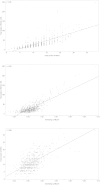Inbreeding and homozygosity in breast cancer survival
- PMID: 26558712
- PMCID: PMC4642301
- DOI: 10.1038/srep16467
Inbreeding and homozygosity in breast cancer survival
Abstract
Genome-wide association studies (GWASs) help to understand the effects of single nucleotide polymorphisms (SNPs) on breast cancer (BC) progression and survival. We performed multiple analyses on data from a previously conducted GWAS for the influence of individual SNPs, runs of homozygosity (ROHs) and inbreeding on BC survival. (I.) The association of individual SNPs indicated no differences in the proportions of homozygous individuals among short-time survivors (STSs) and long-time survivors (LTSs). (II.) The analysis revealed differences among the populations for the number of ROHs per person and the total and average length of ROHs per person and among LTSs and STSs for the number of ROHs per person. (III.) Common ROHs at particular genomic positions were nominally more frequent among LTSs than in STSs. Common ROHs showed significant evidence for natural selection (iHS, Tajima's D, Fay-Wu's H). Most regions could be linked to genes related to BC progression or treatment. (IV.) Results were supported by a higher level of inbreeding among LTSs. Our results showed that an increased level of homozygosity may result in a preference of individuals during BC treatment. Although common ROHs were short, variants within ROHs might favor survival of BC and may function in a recessive manner.
Figures




References
MeSH terms
LinkOut - more resources
Full Text Sources
Other Literature Sources
Medical

